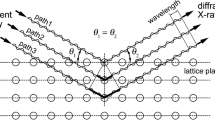Summary
From a simple statistical argument, an intensity expression was formulated for optical diffraction from striated muscle fibres. In terms of the reciprocal space coordinate (Ξ, Φ,u) which corresponds to the real space coordinate (r, φ,x) (thex-axis being parallel to the fibre axis), the intensityI(u, Ξ, Φ) is given by
whereR is the radius of a fibril,J 1(z) is the first-order Bessel function,L(u) is the Laue function for sarcomere repeat along thex-axis,F(u) is the unit cell (or sarcomere) structure factor, Ψ(u, Ξ, Φ) is the structure factor for fibril arrangement in the fibre, 2Δ2 is the variance of out-of-register of fibrils in thex-axis,P is the total number of fibrils in the fibre andP eff is the number of fibrils in an effective rangeR eff of short range order in a cross-section of the fibre. The quantity Ψ(u, Ξ, Φ) expresses the volume effect emphasized from formulation based on the Bragg plane concept. Simulation of the intensity distribution of diffraction lines will be given and an application of the model will be discussed. A reciprocal space representation will also be given of diffraction for a ‘tilt’ Bragg plane model.
Similar content being viewed by others
References
BEAR, R. S. & BOLDUAN, O. E. A. (1950) Diffraction by cylindrical bodies with periodic axial structure.Acta Cryst. 3, 236–41.
BEROVIC, N., O'CONNOR, D. A. & THORNHILL, R. A. (1982) Study of muscle structure using laser light scattering. InBiomedical Applications of Laser Light Scattering (edited by SATTELLE, D. B., LEE, W. I. and WARE, B. R.), pp. 283–289. Amsterdam: Elsevier.
FUJIMI, S. (1975) Optical diffraction study of muscle fibres.Biochim. Biophys. Acta 397, 227–38.
FUJIME, S. MAEDA, T. & UMAZUME, Y. (1981) Structure and dynamics of muscle cells and muscle proteins studied by intensity fluctuation spectroscopy of laser light. InScattering Techniques Applied to Supramolecular and Non-Equilibrium Systems (edited by CHEN, S.-H., CHU, B. and NOSSAL, R.), pp. 725–745. New York: Plenum.
FUJIME, S. & YOSHINO, S. (1978) Optical diffraction study of muscle fibers. I. A theoretical basis.Biophys. Chem. 8, 305–15.
ISHIWATA, S., MURAMATSU, K. & HIGUCHI, H. (1984) Dissembly from both ends of thick filaments in a rabbit skeletal muscle fiber. An optical diffraction study.Biophys. J. (in press).
JAMES, W. R. (1950)The Optical Principles of the Diffraction of X-rays. London: Bell.
LEUNG, A. F. (1982) Laser diffraction of single intact cardiac muscle cells at rest.J. Musc. Res. Cell Motility 3, 399–418.
LEUNG, A. F. (1983) Light diffraction by striated muscle fibres in the transverse direction.J. Musc. Res. Cell Motility 4, 557–68.
LEUNG, A. F., HWANG, J. C. & CHEUNG, Y. M. (1983) Determination of myofibrillar diameter by light diffractometry.Pflügers Arch. 396, 238–42.
RÜDEL, R. & ZITE-FERENCZY, F. (1979) Interpretation of light diffraction by cross-striated muscle as Bragg reflexion of light by the lattice of contractile proteins.J. Physiol. 290, 317–30.
RÜDEL, R. & ZITE-FERENCZY, F. (1980) Efficiency of light diffracted by cross-striated muscle fibres under stretch and during isometric contraction.Biophys. J. 30, 507–16.
UMAZUME, Y. & FUJIME, S. (1975) Electro-optical property of extremely stretched skinned muscle fibres.Biophys. J. 15, 163–80.
YOSHINO, S., UMAZUME, Y., NATORI, R., FUJIME, S. & CHIBA, S. (1978) Optical diffraction study of muscle fibres. II. Electro-optical properties of muscle fibres.Biophys. Chem. 8, 317–26.
Author information
Authors and Affiliations
Rights and permissions
About this article
Cite this article
Fujime, S. An intensity expression of optical diffraction from striated muscle fibres. J Muscle Res Cell Motil 5, 577–587 (1984). https://doi.org/10.1007/BF00713262
Received:
Issue Date:
DOI: https://doi.org/10.1007/BF00713262




